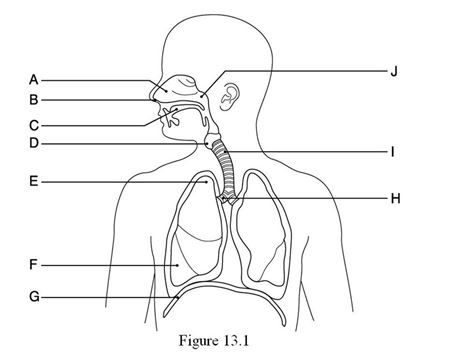A) 500 mL
B) 1200 mL
C) 2100 mL
D) 4800 mL
E) 6000 mL
Correct Answer

verified
Correct Answer
verified
Essay
Explain the roles of mucus and cilia in the respiratory system.
Correct Answer

verified
Respiratory mucosa lines the nasal cavit...View Answer
Show Answer
Correct Answer
verified
View Answer
True/False
The respiratory membrane is the air-blood barrier, where gases are exchanged.
Correct Answer

verified
Correct Answer
verified
Multiple Choice
Which tissue forms the epiglottis?
A) thyroid cartilage
B) elastic cartilage
C) hyaline cartilage
D) fibrous cartilage
Correct Answer

verified
Correct Answer
verified
Multiple Choice
Damage to the larynx can cause an inability to ________.
A) sneeze
B) cough
C) speak
D) hiccup
Correct Answer

verified
Correct Answer
verified
Multiple Choice
Match the following definitions with their associated respiratory volume or capacity: -Amount of air that can be inhaled forcibly over the tidal volume
A) vital capacity
B) dead space volume
C) expiratory reserve volume
D) inspiratory reserve volume
E) residual volume
F) tidal volume
Correct Answer

verified
Correct Answer
verified
Multiple Choice
The three mucosa-covered projections into the nasal cavity that greatly increase surface area of mucosa exposed to air are called ________.
A) tonsils
B) adenoids
C) conchae
D) paranasal sinuses
Correct Answer

verified
Correct Answer
verified
Multiple Choice
The homeostatic imbalance associated with the death of many full-term newborn infants is called ________.
A) CF
B) SIDS
C) CTRL
D) COPD
E) IRDS
Correct Answer

verified
Correct Answer
verified
Multiple Choice
The lack of adequate surfactant can result in ________.
A) adenocarcinoma
B) chronic obstructive pulmonary disease (COPD)
C) tuberculosis
D) asthma
E) infant respiratory distress syndrome (IRDS)
Correct Answer

verified
Correct Answer
verified
Multiple Choice
What is the role of mucus in the nasal cavity?
A) increase the air turbulence in the nasal cavity
B) separate the oral cavity from the nasal cavity
C) lighten the skull
D) act as a resonance chamber for speech
E) trap incoming bacteria and other foreign debris
Correct Answer

verified
Correct Answer
verified
Multiple Choice
The respiratory movement representing the total amount of exchangeable air is the ________.
A) tidal volume
B) inspiratory reserve volume
C) expiratory reserve volume
D) vital capacity
E) dead space volume
Correct Answer

verified
Correct Answer
verified
Multiple Choice
What part of the larynx is commonly called the Adam's apple?
A) glottis
B) thyroid cartilage
C) vocal folds (True vocal cords)
D) trachea
E) epiglottis
Correct Answer

verified
Correct Answer
verified
True/False
Wheezing is a whistling sound associated with diseased respiratory tissue, mucus, or pus.
Correct Answer

verified
Correct Answer
verified
True/False
The nasal cavity is separated from the oral cavity by the nasal conchae.
Correct Answer

verified
Correct Answer
verified
Multiple Choice
When breathing in, air enters the larynx through an opening called the ________.
A) glottis
B) epiglottis
C) esophagus
D) thyroid cartilage
Correct Answer

verified
Correct Answer
verified
Multiple Choice
 Using Figure 13.1, identify the following:
-The apex of the right lung is indicated by ________.
Using Figure 13.1, identify the following:
-The apex of the right lung is indicated by ________.
A) Label E
B) Label F
C) Label H
D) Label G
E) Label J
Correct Answer

verified
Correct Answer
verified
Multiple Choice
Which one of the following is NOT True of the lungs?
A) The narrower portion of each lung is called the apex.
B) The bases rest on the diaphragm.
C) The left lung has two lobes.
D) The right lung has three lobes.
E) Both lungs have two lobes.
Correct Answer

verified
Correct Answer
verified
Multiple Choice
The superior portion of each lung is the ________.
A) pleura
B) base
C) apex
D) mediastinum
E) fissure
Correct Answer

verified
Correct Answer
verified
Multiple Choice
The total amount of exchangeable air is known as ________.
A) residual volume
B) inspiratory reserve volume (IRV)
C) tidal volume (TV)
D) vital capacity (VC)
Correct Answer

verified
Correct Answer
verified
Multiple Choice
 Using Figure 13.1, identify the following:
-The pharynx is indicated by ________.
Using Figure 13.1, identify the following:
-The pharynx is indicated by ________.
A) Label H
B) Label I
C) Label J
D) Label F
E) Label B
Correct Answer

verified
Correct Answer
verified
Showing 81 - 100 of 150
Related Exams